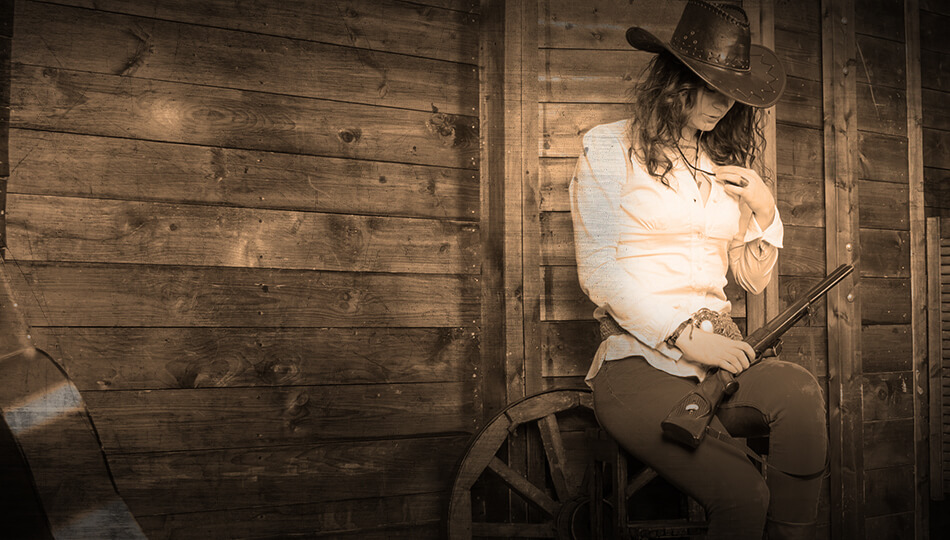
March has been celebrated as Women’s History Month since 1987, when it was created through an act of Congress and is designated each year through presidential proclamation. The focus of this celebration is to recognize and honor the contributions and achievements women have made over the course of American history in a variety of fields. Often overlooked are the achievements of women with firearms, so here’s a brief look at some “badass” ladies with guns.
Annie Oakley
Perhaps the most famous gun-toting woman of history is “Little Miss Sure Shot,” Annie Oakley. During her lifetime, Phoebe Ann Moses (Annie Oakley’s given name) traveled the world, becoming a legendary shooting star in a very male-dominated sport.
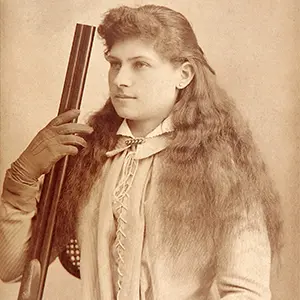
Annie Oakley’s early life in Ohio was troubled. She lost her father to pneumonia at age 6, and the family of eight slipped into poverty. Annie Oakley and a sister were sent to live at an infirmary and with other families. At age 8, she began trapping and hunting, selling the game she shot to local restaurants. Within seven years, her outdoor skills paid off the mortgage on her mother’s farm.
On Thanksgiving Day 1875, the Baughman & Butler shooting act came to Cincinnati. Hotel owner Jack Frost made a $100 bet that a local shooter could beat Frank Butler, the act’s lead, and fronted 15-year-old Annie Oakley. She hit 25 straight shots. Butler missed his 25th target, losing the match and the bet. Impressed by her skills, Butler began courting Oakley. They were married in 1876.
The couple continued touring, with Annie Oakley acting as Frank Butler’s assistant and holding items for him to shoot. She also did some shooting, and adopted the stage name Annie Oakley as she became popular. When Butler’s 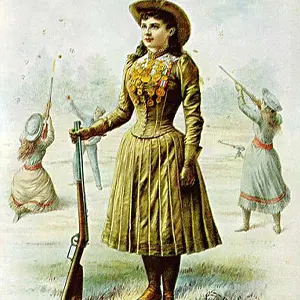 shooting partner became ill in 1882, Annie Oakley filled in as a permanent part of the act. The couple toured for a year with the Sells Brothers Circus, then joined Buffalo Bill’s Wild West Show, performing as partners. However, it was Annie Oakley who quickly rose to fame. Butler supported his wife as her assistant and manager. Annie Oakley shot glass balls out of the air, split playing cards on edge at 30 paces, and shot cigarettes out of her husband’s mouth. In March 1884, Lakota chief and holy man Sitting Bull gave her the nickname “Little Sure Shot” after watching her perform.
shooting partner became ill in 1882, Annie Oakley filled in as a permanent part of the act. The couple toured for a year with the Sells Brothers Circus, then joined Buffalo Bill’s Wild West Show, performing as partners. However, it was Annie Oakley who quickly rose to fame. Butler supported his wife as her assistant and manager. Annie Oakley shot glass balls out of the air, split playing cards on edge at 30 paces, and shot cigarettes out of her husband’s mouth. In March 1884, Lakota chief and holy man Sitting Bull gave her the nickname “Little Sure Shot” after watching her perform.
Annie Oakley toured with Buffalo Bill for 16 years, traveling around the U.S. and abroad. They performed for Queen Victoria’s Golden Jubilee in England and visited Spain, Italy, and France. In 1894, Thomas Edison filmed her stage act for one of his early Kinetoscopes.
Annie Oakley showed people around the world that women were equally capable with firearms and could out-shoot men. She encouraged women to learn how to use pistols to protect themselves and was passionate about empowering women and helping children.
For more information on Oakley, visit https://www.womenshistory.org/education-resources/biographies/annie-oakley
Calamity Jane
Martha Jane Cannary—better known as Calamity Jane—was one of the rowdiest, most adventuresome women of the Old West. Born in Missouri in 1852, Calamity Jane would grow up to dress and act like a man, shoot like a cowboy, and exaggerate her life stories to anyone who would listen.
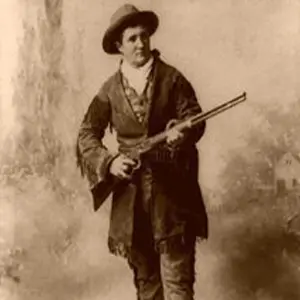
Calamity Jane rode horses and loved the outdoors as a child. Her family moved west to Virginia City, Montana, in 1865, and then to Utah. As the oldest child, Calamity Jane became responsible for her siblings after her parents’ deaths in 1866. She took the clan to Wyoming, where she began working as a cook, nurse, dance-hall girl, dishwasher, waitress, ox-team driver, and—according to some—a prostitute.
In 1870, she joined Lt. Col. George Armstrong Custer’s 7th Cavalry as a scout, where she first dressed like a man, and continued scouting for Custer and Generals Nelson Miles and George Crook during their 1873 campaigns against the Cheyenne and other Native American tribes.
Calamity Jane earned her nickname at Goose Creek in Wyoming, when troops sent out to quell a Native American uprising were ambushed on their return to the post. Calamity Jane rescued the commander, Captain Egan, who gave her the sobriquet “Calamity Jane, the heroine of the plains.”
Calamity Jane met Wild Bill Hickok on his way to Deadwood, South Dakota, in a wagon train. Exaggerators and heavy drinkers, they quickly became friends—yet most historians agree they were not romantically involved.
In Deadwood, Calamity Jane worked as a Pony Express rider. She was in Deadwood in 1876 when Wild Bill Hickok was shot. She remained in Deadwood, prospecting at mining camps, and nursed many townspeople back to health during a smallpox epidemic. While out riding in 1877, she met a stagecoach running from Cheyenne, Wyoming, to Deadwood with Native Americans in hot pursuit. She pulled alongside, took the arrowed driver’s seat, and drove the coach and its six passengers into Deadwood.
By the late 1870s, Calamity Jane’s notoriety attracted writers, and she began appearing in dime novel tales. Restless, she bought a cattle ranch on the Yellowstone River and kept a wayside inn. She traveled to California and then Texas, where she married Clinton Burk in 1885 and gave birth to a baby girl. The couple ran a hotel in Colorado for a time.
Her horsemanship and shooting skill took Calamity Jane into Buffalo Bill’s Wild West Show in 1895. She performed sharpshooting feats from horseback, touring Minneapolis, Chicago, St. Louis, and Kansas City, but her growing alcoholism got her fired from the show.
A newspaper editor found Calamity Jane in a bawdy house in 1900 and nursed her back to health. She was hired by the Pan American Exposition in Buffalo, New York, in 1901—a good job with fine pay—but she got drunk, shot out the bar glass, made Irish policemen dance the jig to her pistols, and then stumbled down the street cussing the town. She was run out of Buffalo.
In 1903, she returned to South Dakota to cook and do laundry for Madam Dora DuFran’s brothel in Belle Fourche. Alcoholism claimed Calamity Jane’s life in August 1903. She was buried beside Wild Bill Hickok in Mt. Moriah Cemetery, her final request. Her funeral was Deadwood’s largest for a woman.
For her complete story, visit https://www.legendsofamerica.com/we-calamityjane/
Enjoying this content? Find out how you can get more sent straight to your inbox.
Stagecoach Mary
Mail thieves didn’t stand a chance against “Stagecoach Mary,” who sported men’s clothing along with an attitude and two guns. Mary Fields was the first Black woman star-route mail carrier and the second woman to carry mail in U.S. history.
Born into slavery in Tennessee and freed after the Civil War, Mary Fields worked as a chambermaid on a Mississippi River steamboat and then in Judge Edmund Dunne’s household. After Dunne’s wife died, he sent Fields and his five children to live with his sister, Mother Mary Amadeus, who was Mother Superior of an 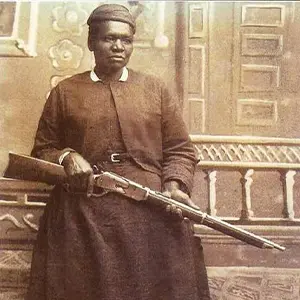 Ursuline convent in Ohio. In 1884, Mother Amadeus was transferred to St. Peter’s Mission, near Stevensville, Montana Territory, to establish a school for Native American girls. There, she contracted pneumonia. Mary Fields nursed the nun back to health.
Ursuline convent in Ohio. In 1884, Mother Amadeus was transferred to St. Peter’s Mission, near Stevensville, Montana Territory, to establish a school for Native American girls. There, she contracted pneumonia. Mary Fields nursed the nun back to health.
Mary Fields stayed at St. Peter’s doing “man’s work,” eventually becoming forewoman of the mission. However, her hearty temperament, drinking, and habitual profanity didn’t sit well with the nuns. In 1894, following complaints and a gunplay incident, the bishop barred Mary Fields from the convent.
She moved to Cascade, Montana, where she opened a short-lived tavern. Then, in 1895, Mary Fields won the bid on a U.S. Post Office Star Route Carrier contract to deliver mail along a 200-mile route. From 1895 to 1903, Mary Fields thwarted bandits and delivered mail along her route, toting several firearms, including a .38 Smith & Wesson, under her apron. Her stagecoach was pulled by horses and a mule named Moses. She never missed a day. If the snow was too deep for her horses, Fields delivered mail on snowshoes.
For more about Mary Fields, visit: https://www.nps.gov/people/mary-fields.htm
Pearl Hart
One especially badassed female gunslinger was Pearl Hart. Born Pearl Taylor in 1871 into an affluent, religious Canadian family, Pearl was enrolled in boarding school at 16 where she fell for a young man named Hart, described as a “rake, drunkard, and gambler.” The lovebirds eloped, but Pearl Hart soon discovered her new husband was abusive and returned to her mother. Although the couple reconciled several times and had two children—who Pearl Hart sent to her mother in Ohio—the marriage didn’t last.
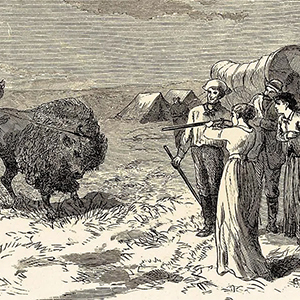
However, while attending the Chicago World’s Fair in 1893 with her husband, Pearl Hart developed a fascination with cowboys and Annie Oakley in Buffalo Bill’s Wild West Show. She again left her husband and ended up in Arizona, where she worked as a boardinghouse cook and singer, possibly supplementing her income with a tent brothel near a mine. She also supposedly developed a fondness for cigars, liquor, and morphine. When the mine petered out, her income dropped.
To raise money, in May 1899 Pearl Hart and Joe Boot decided to rob the Globe-to-Florence stagecoach, one of the last stages operating in Arizona. Pearl Hart cut her hair, donned men’s clothing, and, armed with a .38 revolver (Boot had a Colt .45), stopped the stage at Cane Springs Canyon. Joe Boot and Pearl Hart collected $431 and several guns. (Pearl Hart returned $1 to each passenger.) While the bandits galloped off, a stage driver unhitched a horse and rode back to town to get Pinal County Sheriff Truman.
A posse caught the bandits, both asleep, on June 5. Joe Boot surrendered quietly, but Pearl Hart struggled. Following their arrest, Joe Boot was held in Florence while Pearl Hart was moved to Tucson. A female robber sparked a media frenzy, and reporters clamored for Pearl Hart’s story. Locals also became fascinated, one man giving her a bobcat cub for a pet.
At their October robbery trial, Pearl Hart claimed she needed money to go to her ailing mother. A jury found the pair not guilty. However, Joe Boot and Pearl Hart were immediately re-arrested on mail tampering charges and convicted in a second trial. Joe Boot got 30 years and Pearl Hart five, both in Yuma Territorial Prison. Two years into his sentence, Joe Boot escaped, never to be captured. The attention Pearl Hart had received in Tucson continued in prison at Yuma. The warden provided her with an oversized cell with a small yard so she could entertain reporters and pose for photos. In 1902, Pearl received a pardon from Arizona territory Governor Alexander Brodie on the condition she leave Arizona.
For more information about Pearl Hart, visit https://en.wikipedia.org/wiki/Pearl_Hart
Belle Starr
Another of the famous female outlaws was Belle Starr, “a most desperate woman” according to an 1889 newspaper. This crack shot rode her horse sidesaddle while dressed in a black velvet riding habit and a plumed hat. She carried two Colt .45 pistols, one she called “my baby,” with cartridge belts across her hips.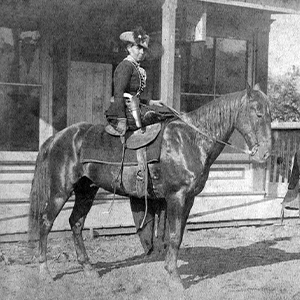
Born Myra Maybelle Shirley in 1848 to the “black sheep” of a well-to-do Virginia family and kin to the Hatfields of feuding fame, Belle Starr received a classical education and graduated from Missouri’s Carthage Female Academy, a private school her father helped found. Her brother “Bud” Shirley, six years older, was active with the Missouri guerillas who fought Yankee troops that had been sent to compel Missouri to join the Civil War against the Confederacy. Belle Starr is rumored to have been a Rebel spy. Bud was killed by federal troops in 1864.
At age 16, with the family business ruined by war, the Shirleys set out for Scyene, Texas, a small town southeast of Dallas. There, Belle Starr married James Reed. Reed farmed, but soon turned to crime. He was wanted in Arkansas for a murder and got involved with several criminal gangs, including the Starr clan, a Cherokee family notorious for whiskey, cattle, and horse thievery, as well as his wife’s friends Jesse James and the Youngers.
In April 1874, despite a lack of evidence, a warrant was issued for Belle Starr for a stagecoach robbery committed by her husband. Reed was killed in August in Paris, Texas, where he had settled the family.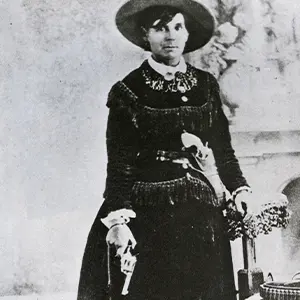
In 1880, Belle Starr married Sam Starr, a Cherokee, and settled with the Starr family in what is now Oklahoma. There she learned to organize, plan, and fence stolen livestock for the horse thieves and bootleggers associated with the family. Her ill-gotten gains led her to bribe lawmen to free her accomplices when arrested. Yet in 1883, the famous Black sheriff Bass Reeves arrested Sam and Belle Starr for horse stealing and tried them before “The Hanging Judge” Isaac Parker in Fort Smith, Arkansas. Belle Starr served nine months in jail in Detroit, Michigan.
In 1886, Belle Starr eluded another theft charge, but Sam Starr fell in a gunfight with the law. After his death, Belle Starr was linked to Jack Spaniard, Jim French, and Blue Duck. To keep her home on Native American land, she married Jim July Starr, 15 years her junior.
Ruthless to her enemies, Belle Starr had a great capacity to make friends, even mingling with Dallas’s elite during her brief periods of respectable living.
Belle Starr was shot and killed by an unknown assailant two days before her 41st birthday while riding home from a neighbor’s house. She lived on when her story, considerably embellished, was published in the National Police Gazette. Later, she became a popular character in television and films.
For more information on Belle Starr, visit https://www.humanitiestexas.org/programs/tx-originals/list/belle-starr.
Famous Female Gunslingers FAQ’s
Your Protection Starts Here!
The information provided in this publication is intended to provide general information to individuals and is not legal advice. The information included in this publication may not be quoted or referred to in any other publication without the prior written consent of U.S. LawShield, to be given or withheld at our discretion. The information is not a substitute for, and does not replace the advice or representation of a licensed attorney. We strive to ensure the information included in this publication is accurate and current, however, no claim is made to the accuracy of the information and we are not responsible for any consequences that may result from the use of information in this publication. The use of this publication does not create an attorney-client relationship between U.S. LawShield, any independent program attorney, and any individual.





Very glad to see this article about the women! It even more rewarding seeing that yall included an African American as part of the Western History and you just don’t see that much even today! Very proud to be a member
Thanks for being a member!
Great to see your story about Famous Female Gunslingers. You should also do a story on one of the best female gunslingers of all time – Plinky Toepperwein. Annie Oakley was a contemporary and declared her the best shot she’d ever seen. Her and her husband Ad Toepperwein were fabulous shots and traveled the country over with their exhibitions, working for Winchester. They are ancestors of mine. Speaking of Ad (Adolph), he set all sorts of records, many of them were quite unbelievable, but they are true. Plinky’s real maiden name was Elizabeth Servaty. There is an interesting story about how she got her nickname, “Plinky.” Do a Google search, there’s lots of material on them.
Karl Wendler, Member
Thanks for reading!
these were great and entertaining stories. thanks.
Thanks for reading!
Very interesting. Well done.
Thanks for reading!
I enjoyed your article about ‘Famous Female Gunslingers’. Missing in the article, however is mention of F.M. Miller, the first female U.S. deputy Marshall in the Indian territory (1891). She’s worthy of recognition because she was one woman who was extremely adept at handling any kind of firearm AND wanted to bring law and Justice to the most corrupt territory of her day. Unlike others mentioned, Mrs. Miller did not resort to lawlessness and is a model for gun-toting women today. BTW, I’m a 73 year old grandmother and US Lawshield member.
Thanks for the feedback!